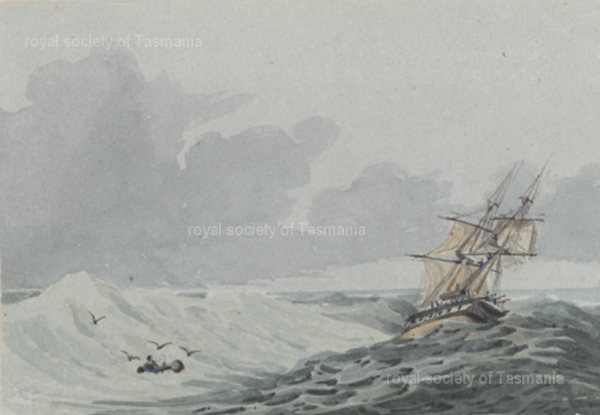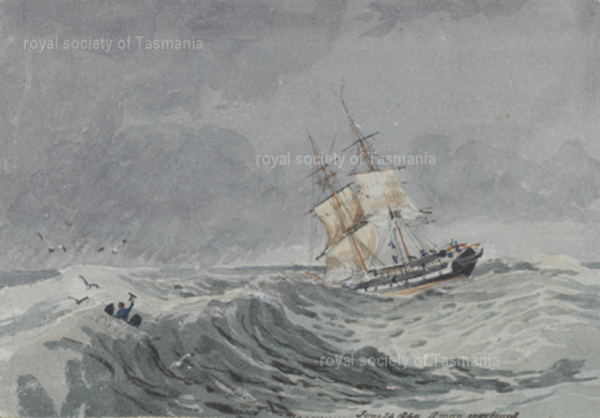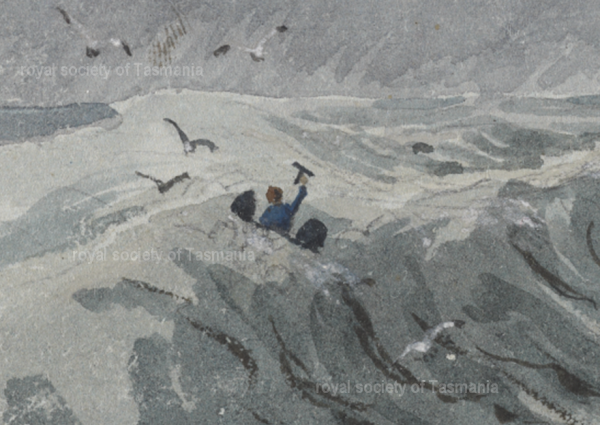Stories from the Royal Society of Tasmania Art Collection
1. Captain Owen Stanley
Article prepared by the RST Honorary Curator, Dr Anita Hansen, for the February 2022 RST Newsletter.
Note: Some images may be enlarged by clicking on them.
As the new Honorary Curator of the Society’s Art Collection I will be delving into the amazing collection each month to bring you some snippets about the artists and works included in it.
I thought I’d start with one of the less highlighted artists in the collection, Captain Owen Stanley. The two main watercolours of Stanley’s from the collection featured in this article intrigued me when I first encountered them. Not least because they are beautiful artworks, but they tell such a powerful story – full of drama and danger – the fury of a storm at sea, a man lost overboard, the desperate attempts by his fellow sailors to rescue him, and the perils of nineteenth century maritime exploration.
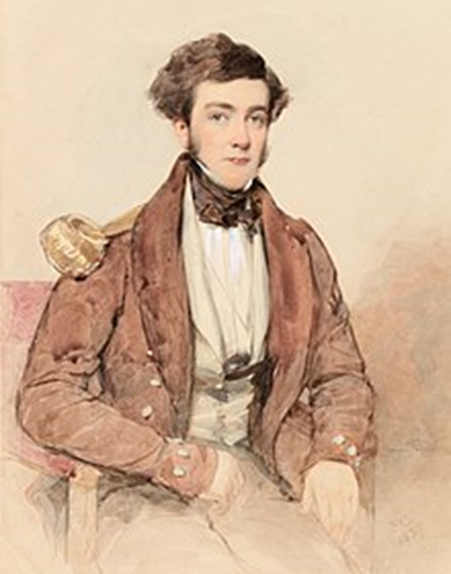
How Stanley’s artworks came to be in the Society’s collection
In the late nineteenth century with the Federation of the Australia states imminent, the Royal Society of Tasmania, fearing the loss of Tasmania’s identity, made a decision to set about collecting historical documents and artworks that would chronicle the story of European settlement in Tasmania.
As a result, Eliza Stanley, the widow of Charles Stanley, Private Secretary to Sir William Denison, donated some of her brother-in-law’s (Owen) watercolours to the Society. Captain Charles Stanley and Eliza had moved to Tasmania in 1841. While in Tasmania Charles became an active member of the Society. After his death in 1849 Eliza returned to England.
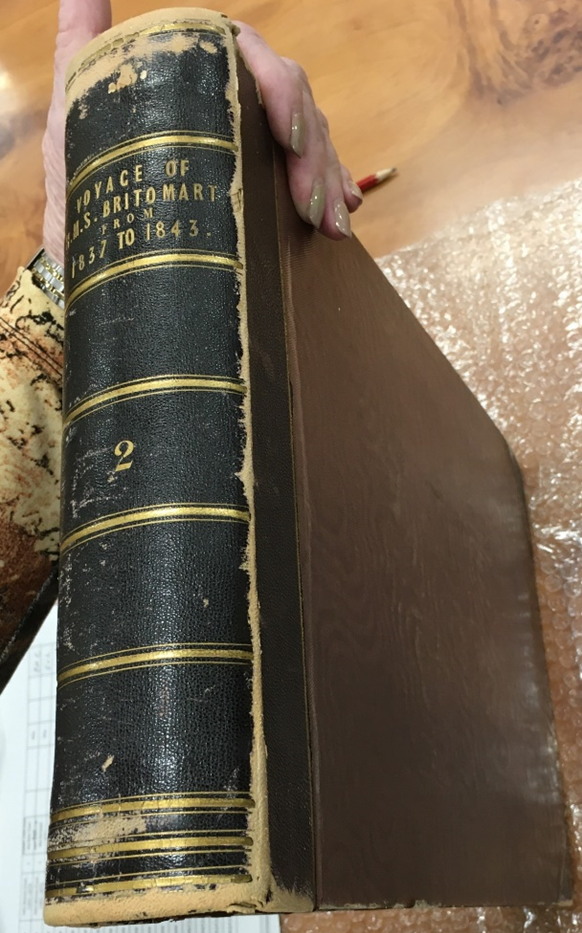
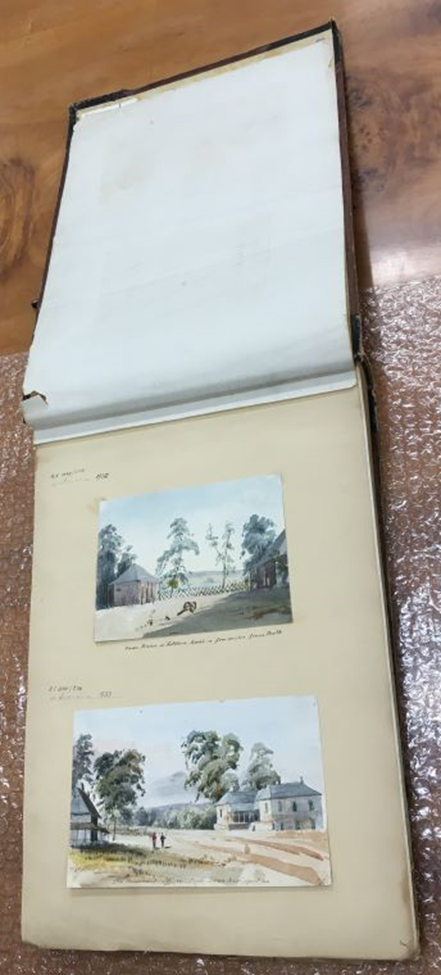
Owen Stanley
Owen Stanley (1811–1850), was born on 13 June 1811. He entered the Royal Naval College aged only fifteen. After graduating he swiftly rose through the ranks, and at the age of twenty-six he was given his first independent command, the brig Britomart. In 1837/8 he sailed for the East Indies and Australasian waters, chiefly on surveying work. The watercolours in the Society’s collection are from this voyage.
In June 1848 he sailed to south-east New Guinea to complete more surveys of the coast. On this voyage he contracted an illness from which he died in Sydney in March 1850.
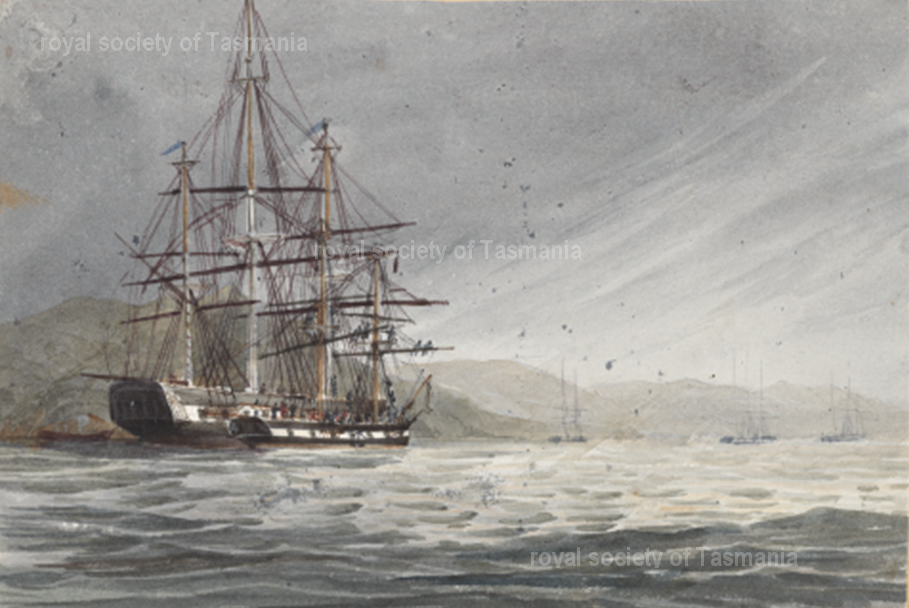
Man Overboard
This month I will showcase two of the sketches from the Society’s folio to show not only Owen’s skill as an artist, but also to reveal his talent as a visual story teller.
Stanley often wrote a paragraph or two explaining the paintings.

In describing these two sketches he wrote:
“In shortening sail off the north point of New Zealand with a heavy sea running and every appearance of bad weather coming on one of the forecastle men was pitched off the jib boom while stowing the jib – the life buoy was set at once let go and he succeeded in gaining it …”
This painting is extraordinarily evocative. We can imagine the desperation of the adrift sailor clinging to the buoy, fearing he will be lost from sight in the tumultuous waves and threatening storm.
Owen continues:
“ … but was twenty minutes holding on to it before the boat reached him during which time he had great difficulty in defending himself from the attacks of the albatross.”
In a close-up of the sailor, we can see him fighting off the attack by the birds. If you look closely, you can also see the faint pencil sketch of another view of the sailor, frantically waving, just below the coloured version.
Owen Stanley as an artist
While Stanley’s achievements were principally scientific – he was made a fellow of both the Royal Society and the Royal Astronomical Society for his surveying and observation work – he is now also recognised as a skilled maritime artist.
Owen Stanley’s maritime paintings are held in several libraries and museums. The image below is from the Royal Museums Greenwich (rmg.co.uk).

Described by former National Maritime Museum curator James Taylor in The Voyage of the Beagle (Conway, 2008, p.26) as: ‘… the best-known watercolour image of the survey ship, although it relates to her third and final expedition in 1837–43. It was created by Commander Owen Stanley (1811–50), captain of HMS Britomart, a sister-ship of the Beagle, who was also an artist of promising ability and occasionally produced accomplished work. Stanley’s picture featuring the Beagle was completed when Britomart came into contact with the Beagle in Australian waters. It is loosely constructed and to a small scale (the size of a large postcard). It is full of atmosphere and charm …’ (rmg.co.uk).
Owen Stanley in Tasmania
HMS Britomart visited Hobart while Stanley was in command. Stanley had served with John Franklin aboard HMS Rainbow in 1831 and the two had remained friends. While in Van Diemen’s Land Stanley visited Port Arthur, making sketches of the trip that are also in the Society’s collection – but they are a story for another day.
Owen Stanley’s watercolours in the Society’s collection, like the one above at Greenwich are small in scale. They are, however, a valuable slice of Tasmania’s cultural and historical heritage.
Aside
As a part of these monthly articles, I would also like to ask your help in my research of the Society’s art collection.
I am currently working on the Louisa Anne Meredith natural history paintings and would very much appreciate any information you may have in her (or other’s) diaries or letters relating to comments about her painting. Thank you.
The Royal Society of Tasmania’s Art Collection is housed at the Tasmanian Museum and Art Gallery, Hobart.
Any queries, please contact the Honorary Curator, Dr Anita Hansen: anita.hansen@utas.edu.au
